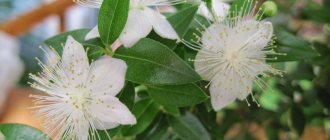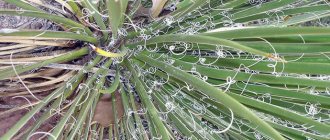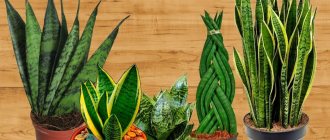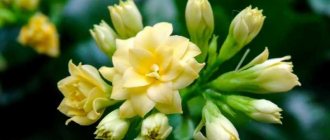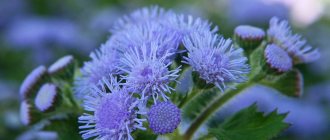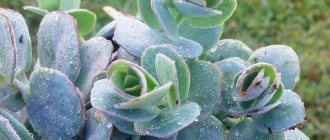Dieffenbachia - reproduction
Question: Everyone’s Dieffenbachia cuttings easily take root in water, but mine drops leaves and rots?
Natali: In order for Dieffenbachia to take root safely in water and not rot (loss of leaves is quite acceptable), you need to take clean water, not boiled, but preferably filtered, add 4-5 tablets of activated carbon per half liter, do not keep the jar of water in the light ( You can wrap it in a napkin) and change the water periodically for fresh water. You can also root in a weak fertilizer solution. Any fertilizer for decorative foliage plants, taken in a dose 4 times less than recommended for root feeding.
If rotting (the bottom of the cutting becomes slimy and darkens) has begun, then you can cut off the damaged part of the stem to healthy tissue, rinse the cutting in running water, place it in fresh water, to which add a few drops of phytosporin. After 2-3 days, replace the water with fresh water, add phytosporin again, but 2 times less. If there is no phytosporin, add ground cinnamon on the tip of a knife.
If Dieffenbachia is rooted in the ground, then it does not need to be covered with a bag or jar, but the cuttings must be sprayed 2 times a day. And the soil should be kept only slightly moist. Of course, the soil should be sterilized (soak it in the microwave for about 3 minutes), and the cut of the cutting should be sprinkled with crushed charcoal.
Caring for Dieffenbachia - in the section of the Encyclopedia of indoor plants.
Kroky: A possible reason for the trunk rotting in water is the cut touching the bottom of the jar. Try to arrange it somehow so that the cut hangs in the water. You can also sprinkle the cuts with charcoal. The leaves, by the way, have the right to turn yellow and fall off in the process, don’t be alarmed. And cuttings from the trunk need 2-3 rings.
aie13: I root exclusively in water: a 3-liter jar of boiled water + 5 tablets of activated carbon, I wrap the jar with a black garbage bag (so that it is dark in the jar). The crown in the cut-off state is usually about a meter long, I dry the cut for 2-3 hours and put it in a jar, it was very correctly noted earlier that the cut should not touch the bottom - otherwise 50% of the decay is inevitable. After 3-4 weeks, small roots appear - now into the ground. Inevitably I lose a few of the lower leaves.
Question: I’m trying to root a Dieffenbachia cutting, but nothing is working!
Reproduction of Dieffenbachia - in the section Popular indoor plants
polin: When rooting Dieffenbachia cuttings, I noticed an interesting trend - if the cutting is apical, then the roots take longer to appear than if the cutting is cut from the middle of the trunk (without the top). Maybe with two tops the rooting process is naturally delayed?
Kroky: Indeed, the higher up the trunk, the longer the roots take to grow. In root cuts, roots can appear within a week. Therefore, there is little point in comparing the rate of root appearance in different people. Even on thin, recently grown shoots, roots will also appear faster than on old, thick ones. But the latter will develop large leaves faster.
Lelya: My stalk (it has dropped all its leaves) has been sitting in the water for about 20 days and only now a tubercle has appeared and a hint of a new leaf.
Elena: I rooted Dieffenbachia twice. The first time in the ground under a jar, the second time in water with activated carbon. The second method is much easier; my Dieffenbachia took root in two weeks.
Watering
It is important not to deny Dieffenbachia watering. I water it with settled water about once every three days and after 20 minutes I drain the draining water from the pan. She cannot tolerate dryness. At least until the top layer of soil dries out a couple of centimeters, it still endures, and then it begins to suffer.
If the soil dries out completely, the plant will stop growing and drop its leaves.
If there is excess moisture, the roots can rot, so we also do not allow overwatering. In winter, spraying is sufficient for the tree.
Dieffenbachia after pruning
Question: The trunk of my Dieffenbachia has begun to become bare. It's not very pretty. I want to plant a second one in this pot. Tell me, if I cut off the top and root it in water, what will happen to the mother plant. How will Dieffenbachia continue to grow without a crown?
polin: Without a crown - it will send out side shoots. That's all. I chop my healthy one like firewood every 2 years.
Alla Viktorovna: I also cut mine in half, the top took root in the water, and the stump produced a new shoot from the upper bud in the area of the “bridge” on the trunk. Now I have two Dieffenbachia!
Dieffenbachia leaves drying out
Question: I recently purchased Dieffenbachia, and when I brought it home, I discovered several black spots on the leaves. They increase in size.
Natali: The leaves of your Dieffenbachia do not turn yellow, but dry out, acquiring a dark, blackish color. This is a sign of waterlogging - it was systematically filled in at the store. It is necessary not only to replant into new soil, but also to observe the watering regime. You can also use fungicides against root rot; ask the store for drugs that help against late blight; you can pour in a solution of phytosporin.
- If the leaves of Dieffenbachia dry out and become light, like parchment, the reason is due to overdrying or too dry (and hot) air. Dieffenbachia likes humidity to be around 50-60%. If spraying 2-3 times a day does not help, you need to purchase an air humidifier or cover the batteries with damp terry towels.
Question: Why do the ends of Dieffenbachia leaves dry out?
Natali: In such cases, it is customary to go straight to the dry air in the room. Indeed, if the room is very hot and dry, the ends of the leaves of Dieffenbachia may dry out, but if the plant is not located next to the heating system, then dry air is not always the cause, or not the only cause, of dry tips and edges of the leaves. More often, the culprit is over-drying of the earthen coma, lack of nutrition, especially in large specimens that have not been replanted for several years, as well as pests - mites or thrips, which are quite difficult to notice on variegated leaves.
Benefits and harms
The sap of the plant is poisonous and can cause irritation if it comes into contact with exposed skin. In case of accidental contact with mucous membranes, the glands and tongue swell.
All work with flowers (transplanting, pruning, etc.) is best done with thick rubber gloves, and upon completion, wash your hands well with soap. You should not keep it in the children's room, or in a place where the child can reach it.
At the same time, the lovely Dieffenbachia cleanses the air from many harmful substances: xylene, benzene, and various formaldehydes.
Also good for purifying the air: Anthurium, Ficus Benjamin Kinki, Peperomia obtufolia, Hoya Carnosa, Decorative deciduous Begonia, Dracaena Fragrance, Dieffenbachia Spotted and some others.
Dieffenbachia leaves turn yellow
Question: The leaves of Dieffenbachia suddenly began to turn yellow, a visual inspection did not show any pests, what could be the reason?
Alexander: If the leaves suddenly turn yellow, it’s overwatering. And the roots begin to rot. It is necessary to ventilate them, loosen the soil and not water them.
Ksu: Check the soil at a depth of about 2-2.5 cm at the bottom of the pot. If it hasn’t been watered for several days, and the ground is wet (not just wet, but wet), it’s overwatering. It’s better to quickly pull it out of the pot and check the roots. They're probably rotting. Cut off the rotten ones, sprinkle the cuts with charcoal (or activated), although I dump everything that is left of the root system into the charcoal for disinfection. You can keep it in a fungicide solution before “dumping” and after pruning. Plant in slightly moist soil and do not water for several days; it is better to spray. Then water little by little, but more often.
Natali: If the leaves are yellowing with a lemon color (no browning, rather a pale color), a possible cause is a spider mite. It is very difficult to notice when it is in small quantities. A characteristic feature is yellowing without definite boundaries - blurry indistinct spots. Try looking for pests on the undersides of the still green leaves closest to the yellowed ones. Symptoms - see photo of ticks.
Description of the plant
Dieffenbachia is a plant that belongs to the evergreen Araceae family. The regions of America located in the tropical zone are recognized as the birthplace of the flower. The flower received its name from Joseph Dieffenbach, a gardener from Austria.
Many types of Dieffenbachia act as houseplants. They are characterized by a thick stem ending in a tip of leaves that have an elongated oval shape and variegated color. Outside of the wild, the plant blooms very rarely, so not everyone will be able to see the white cob. However, the short flowering period, which lasts a couple of days, occurs in the middle - end of spring. The fruit is an orange-red berry.
A characteristic feature of the plant is its rapid growth. In a short period of time, Dieffenbachia can noticeably stretch out.
Dieffenbachia can reach 2 meters in height, but with such a large growth, the lower part of the stem becomes yellowish, which does not look particularly decorative.
Dieffenbachia juice is believed to be poisonous. This is why many gardeners and flower growers sometimes avoid planting plants. The flower is used in some countries as a drug to kill rats. The plant is safe for humans if not eaten. When processing and cutting parts of an indoor beauty, it is best to arm yourself with gloves. You should not have a flower in your house if there are pets living in it who love to bite everything around it. The sap of the plant, if it gets on their tongue, can cause illness or death.
What kind of pot does Dieffenbachia need?
Question: Does Dieffenbachia like a spacious pot or a cramped one?
Kroky: It grows so quickly, a spacious pot becomes cramped very quickly. Choose a spacious one - the available soil space can be about two to three times larger than the root ball. Do not forget that Dieffenbachia is a powerful plant and the pot must be stable. But if you immediately take a very large pot (the space is 4-5 times larger than the root ball), then the risk of waterlogging increases. Therefore, in a large pot, be careful with watering, or make a higher drainage layer.
When can a transplant be performed?
A plant is usually replanted at home after the roots fill the entire pot completely, sometimes several times a year.
If there is a delay in replanting, the plant may lose leaves, get sick, and become dull. A good time to transplant Dieffenbachia is the end of winter or the beginning of spring, before the start of the growing season. The beginning of May is the deadline for better survival. In the summer, this operation is carried out only in case of emergency, as there is a risk that the plant will not take root.
Signs that the procedure is necessary
- The growth rate of the flower decreases.
- New leaves become smaller.
- The soil dries out quickly after watering.
- The leaves of the flower turn yellow and fall off.
- The roots come to the surface.
What kind of land does Dieffenbachia need?
Question: what kind of land does Dieffenbachia need?
Natali: You need soil that is porous and nutritious, with a good amount of humus. Therefore, store-bought soils in their pure form are not suitable (they consist of fibrous peat seasoned with mineral fertilizers). Therefore, it is better to compose the soil from individual components:
- 3 parts leaf humus, 1 part turf soil, 1 part small pebbles or zeolite granules, 1 part humus (compost soil)
- 2 parts of garden soil from vegetables, under which organic matter was added (tomatoes, cucumbers), 1 part of turf soil, 1 part of coconut substrate (briquettes or chips).
Read about where to get turf or leaf soil: About soil and plant replanting, as well as Soil for plants
It is very important to sterilize the soil before transplanting Dieffenbachia, especially if you bring it from the garden. If the volume of soil is small, you can steam it in the oven on a baking sheet. If the volume is large (a bucket or more), then you can spill it with a very large amount of boiling water. I do this: I pour a little less than a bucket of earth into an old pillowcase, place it in a 15 liter bucket and fill it with boiling water (it takes about 6-7 liters). I leave it for 30-40 minutes, take it out and hang it up to let the water drain for about a day. Then I lay it out on film to dry. Boiling water does not completely sterilize the soil (this requires boiling), but it kills pests, larvae and eggs.
After planting Dieffenbachia, I water it several times with humic preparations, or use Baikal EM-1.
Dieffenbachia stretched out
Question: My Dieffenbachia has an elongated trunk and very long petioles, what could this be connected with? I can't wait to cut it, except it's winter...
Gray: They are elongated because she clearly doesn’t have enough lighting! Now is not the best time of year for houseplants. It's a bit dark. Either move it closer to the window, or arrange additional lighting. Hang a regular fluorescent lamp and add light in the evening. For example, this is what I do: I illuminate many plants until 24 pm. If you move it closer to the window, then pay attention to the radiators. Dieffenbachias do not like dry air, like all other plants. So, it is necessary to humidify the air in the room to increase humidity! No need to cut now! Still, wait until spring, when all plants begin their growing season. Transplantation is also advisable in the spring. There is no need to cause additional stress to the plant.
Question: What should I do if the trunk becomes exposed?
Natali: Dieffenbachia is characterized by gradual exposure of the trunk from below, but this is normal if it grows well and produces new leaves. However, if the new leaves are smaller than the old ones and the petioles are too long, then the plant clearly does not have enough light.
Shlomo: Yellowing of the lower leaves may be normal if the plant is large and there are many healthy leaves, but perhaps this is the result of a draft or lack of light. Dieffenbachia can be illuminated; it develops well even when sunlight is completely replaced with artificial light, and it has a positive attitude toward lengthening daylight hours.
Where to put
- lighting should be good. There should be a lot of light. You need to take care of additional lighting, use lamps or phytolamps. Dieffenbachia does not tolerate shade. The foliage fades and the decorative effect disappears. In summer, we try to prevent direct sunlight from falling on the leaves of Dieffenbachia. This may cause sunburn. Choose a suitable place where the light will be diffused throughout the entire time the plant is in the room. The distance from the windows in the room is about two meters. This will protect the plants from the heat that comes from radiators and heating.
- the temperature for growing Dieffenbachia should be no more than 26 degrees and no lower than 20. The minimum temperature that Dieffenbachia can tolerate is 16 degrees. Lowering the temperature, especially close to 10, can lead to problems with the leaves; they lose their decorative appearance and begin to turn yellow. Also, a sharp decrease in temperature can lead to the death of the plant. But in winter, it is allowed to rearrange or move the plant to a cooler place, taking into account the peculiarities of heating in the house. Being too close to the heating can dry out the soil in the pot and the tips of the leaves will begin to dry out. Protect the plant from drafts. They can cause foliage to turn brown.
-Humidity can be maintained by regularly spraying the leaves. Spraying foliage during the period of active growth (spring-autumn) every day. In winter, it is enough to spray the plant twice a week. Use humidifiers. It is very good to carry out wet cleaning of leaves. Use a soft cloth to wipe the leaves from dust and at the same time moisturize the Dieffenbachia. We maintain humidity 80-90.
Dieffenbachia flowering
Question: Dieffenbachia grew just fine, then it began to bloom. I heard that flowers need to be removed?
polin: If Dieffenbachia starts to bloom and you want to see the flowering, then it just needs increased feeding. My bush bloomed. All the “oppression” was expressed in one sheet of smaller than usual size and that’s all. You just need mandatory weekly fertilizing with mineral and organic fertilizers during the flowering period and after it for at least a month. Then you can switch to the normal feeding mode.
If we proceed from the fact that when we need to support the foliage, we feed it where there is more nitrogen, i.e. as usual “for decorative deciduous trees”. But, since it still blooms, I did one feeding “for decorative flowering plants”, where there is more potassium and phosphorus.
